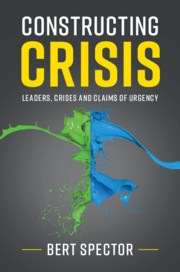Book contents
- Constructing Crisis
- Constructing Crisis
- Copyright page
- Dedication
- Contents
- Tables
- Preface
- 1 Undertaking a New Interpretive Effort
- 2 Crisis as a Reification of Urgency
- 3 Advancing the Crisis-as-Event Model
- 4 Problems, Crises, and Contextual Constructionism
- 5 An Objective Description and a Subjective Uh-Oh!
- 6 Believing Claims of Urgency – Or Not
- 7 The Power of a Good (Crisis) Narrative
- 8 To Create Such a Crisis, to Foster Such a Tension
- 9 Beyond Forged-in-Crisis Leadership
- 10 So What?
- References
- Index
1 - Undertaking a New Interpretive Effort
Published online by Cambridge University Press: 23 August 2019
- Constructing Crisis
- Constructing Crisis
- Copyright page
- Dedication
- Contents
- Tables
- Preface
- 1 Undertaking a New Interpretive Effort
- 2 Crisis as a Reification of Urgency
- 3 Advancing the Crisis-as-Event Model
- 4 Problems, Crises, and Contextual Constructionism
- 5 An Objective Description and a Subjective Uh-Oh!
- 6 Believing Claims of Urgency – Or Not
- 7 The Power of a Good (Crisis) Narrative
- 8 To Create Such a Crisis, to Foster Such a Tension
- 9 Beyond Forged-in-Crisis Leadership
- 10 So What?
- References
- Index
Summary
Constructing Crisis is about an idea, and that is the idea of crisis. What do we mean when we use or hear that term? What suggestions or thoughts are communicated when our leaders deploy the word? And how does that deployment impact the dynamics that unfold within our business organizations, our communities, and our societies?
Most usually, the idea of crisis conjures up images of threatening events, occurrences that present a serious risk. A business crisis, for instance, may take the form of a public revelation of maleficence on the part of key executives or flawed product design that led to injuries or deaths. Unwelcomed takeover bids and serious financial losses might also trigger what we refer to as a crisis. Will the business survive? In that way, we may understand crisis to be not just a risk but also an existential threat, placing the very future of the company in jeopardy.
Information
- Type
- Chapter
- Information
- Constructing CrisisLeaders, Crises and Claims of Urgency, pp. 1 - 17Publisher: Cambridge University PressPrint publication year: 2019
